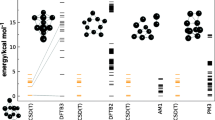Abstract
In this paper we present a method for optimizing of metal nanoparticle structures. The core of the method is a lattice Monte-Carlo method with different lattices combined with an approach from molecular dynamics. Interaction between atoms is calculated using multi-particle tight-binding potential of Gupta – Cleri&Rosato. The method allows solving of problems with periodic boundary conditions. It can be used for modeling of one-dimensional (nanowire, tube) and two-dimensional (nano-film) structures. If periodic boundary conditions are not given, we assume finite dimensions of the model lattice. In addition, automatic relaxation of the crystal lattice can be performed in order to minimize further the potential energy of the system. Both stretching and compressing of the lattice is permitted. A computer implementation of the method is developed. It allows easy and efficient operation. It uses the commonly accepted XYZ format for describing metal nanoparticles. The parameters of the method, such as number and type of metal atoms, temperature of the system, etc. are entered on a separate command line. The method is tested extensively on a large set of examples.
Access this chapter
Tax calculation will be finalised at checkout
Purchases are for personal use only
Similar content being viewed by others
References
Sannicolo, T., Lagrange, M., Cabos, A., et al.: Metallic nanowire-based transparent electrodes for next generation flexible devices: a review. Small 12(44), 6052–6075 (2016)
Luo, M., Liu, Y., Huang, W., Qiao, W.: Towards flexible transparent electrodes based on carbon and metallic materials. Micromachines 8(1), 12 (2017)
Li, H., Biser, J.M., Perkins, J.T., Dutta, S., et al.: Thermal stability of Cu nanowires on a sapphire substrate. J. Appl. Phys. 103(2), 024315-1–024315-9 (2008)
Langley, D.P., Lagrange, M., Giusti, G., Jiménez, C., et al.: Metallic nanowire networks: effects of thermal annealing on electrical resistance. Nanoscale 6(22), 13535–13543 (2014)
Karim, S., Toimil-Molares, M.E., Balogh, A.G., et al.: Morphological evolution of Au nanowires controlled by Rayleigh instability. Nanotechnology 17(24), 5954–5959 (2006)
Rauber, M., Muench, F., Toimil-Molares, M.E., Ensinger, W.: Thermal stability of electrodeposited platinum nanowires and morphological transformations at elevated temperatures. Nanotechnology 23(47), 475710 (2012)
Granberg, F., Parviainen, S., Djurabekova, F., Nordlund, K.: Investigation of the thermal stability of Cu nanowires using atomistic simulations. J. Appl. Phys. 115(21), 213518-1–213518-5 (2014)
Calvo, F.: Solid-solution precursor to melting in onion-ring Pd-Pt nanoclusters: a case of second-order-like phase change? Faraday Discuss. 138, 75–88 (2008)
Davis, J., Johnston, R., Rubinovich, L., Polak, M.: Comparative modelling of chemical ordering in palladium-iridium nanoalloys. J. Chem. Phys. 141, 224307 (2014)
Ferrando, R., Fortunelli, A., Johnston, R.: Searching for the optimum structures of alloy nanoclusters. Phys. Chem. Chem. Phys. 10, 640–649 (2008)
Panizon, E., Olmos-Asar, J., Peressi, M., Ferrando, R.: The study of the structure and thermodynamics of CuNi nanoalloys using a new DFT-fitted atomistic potential. Phys. Chem. Chem. Phys. 17, 28068–28075 (2015)
Parsina, I., DiPaola, C., Baletto, F.: A novel structural motif for free CoPt nanoalloys. Nanoscale 4, 1160–1166 (2012)
Paz-Borbón, L., Mortimer-Jones, Th, Johnston, R., Posada-Amarillas, A., et al.: Structures and energetics of 98 atom Pd–Pt nanoalloys: potential stability of the Leary tetrahedron for bimetallic nanoparticles. Phys. Chem. Chem. Phys. 9, 5202–5208 (2007)
Schebarchov, D., Wales, D.: A new paradigm for structure prediction in multicomponent systems. J. Chem. Phys. 139(22), 221101 (2013). https://doi.org/10.1063/1.4843956
Schebarchov, D., Wales, D.: Quasi-combinatorial energy landscapes for nanoalloy structure optimization. Phys. Chem. Chem. Phys. 17, 28331–28338 (2015)
Shayeghi, A., Götz, D., Davis, J.B.A., Schäfer, R., Johnston, R.L.: Pool-BCGA: a parallelised generation-free genetic algorithm for the ab initio global optimisation of nanoalloy clusters. Phys. Chem. Chem. Phys. 17, 2104 (2015)
Toai, T.J., Rossi, G., Ferrando, R.: Global optimisation and growth simulation of AuCu clusters. Faraday Discuss. 138, 49–58 (2008). https://doi.org/10.1039/b707813g
Bilalbegović, G.: Structures and melting in infinite gold nanowires. Solid State Commun. 115, 73–76 (2000)
Liu, W., Chen, P., Qiu, R., Khan, M., et al.: A molecular dynamics simulation study of irradiation induced defects in gold nanowire. Nucl. Instrum. Methods Phys. Res. Sect. B Beam Interact. Mater. Atoms. 405, 22–30 (2017)
Diao, J., Gall, K., Dunn, M.L., Zimmerman, J.A.: Atomistic simulations of the yielding of gold nanowires. Acta Mater. 54(3), 643–653 (2006)
Zepeda-Ruiz, L.A., Sadigh, B., Biener, J., Hodge, A.M., et al.: Mechanical response of freestanding Au nanopillars under compression. Appl. Phys. Lett. 91(10), 101907-1–101907-3 (2007)
Olsson, P.A.T., Park, H.S.: Atomistic study of the buckling of gold nanowires. Acta Mater. 59(10), 3883–3894 (2011)
He, X., Cheng, F., Chen, Z.-X.: The lattice kinetic Monte Carlo simulation of atomic diffusion and structural transformation for gold. Sci. Rep. 6(1), 33128 (2016)
Baibuz, E., Vigonski, S., Lahtinena, J., Zhao, J., Jansson, V., Zadin, V., Djurabekova, F.: Migration barriers for surface diffusion on a rigid lattice: challenges and solutions. Comput. Mater. Sci. 146, 287–302 (2018). https://doi.org/10.1016/j.commatsci.2017.12.054
Cleri, F., Rosato, V.: Tight-binding potentials for transition metals and alloys. Phys. Rev. B 48, 22–33 (1993)
Sutton, A., Chen, J.: Long-range Finnis-Sinclair potentials. Philos. Mag. Lett. 61, 139–146 (1990)
Myshlavtsev, A.V., Stishenko, P.V.: Modification of the metropolis algorithm for modeling metallic nanoparticles. Omsk Sci. Newsp. 1(107), 21–25 (2012). (in Russian)
Acknowledgments
This research is supported by the Russian Foundation for Basic Research project No. 18-38-00571 mol_a and the Bulgarian NSF under the grant DFNI-DN 12/5.
Author information
Authors and Affiliations
Corresponding authors
Editor information
Editors and Affiliations
Rights and permissions
Copyright information
© 2019 Springer Nature Switzerland AG
About this paper
Cite this paper
Myasnichenko, V., Sdobnyakov, N., Kirilov, L., Mikhov, R., Fidanova, S. (2019). Monte Carlo Approach for Modeling and Optimization of One-Dimensional Bimetallic Nanostructures. In: Nikolov, G., Kolkovska, N., Georgiev, K. (eds) Numerical Methods and Applications. NMA 2018. Lecture Notes in Computer Science(), vol 11189. Springer, Cham. https://doi.org/10.1007/978-3-030-10692-8_15
Download citation
DOI: https://doi.org/10.1007/978-3-030-10692-8_15
Published:
Publisher Name: Springer, Cham
Print ISBN: 978-3-030-10691-1
Online ISBN: 978-3-030-10692-8
eBook Packages: Computer ScienceComputer Science (R0)




